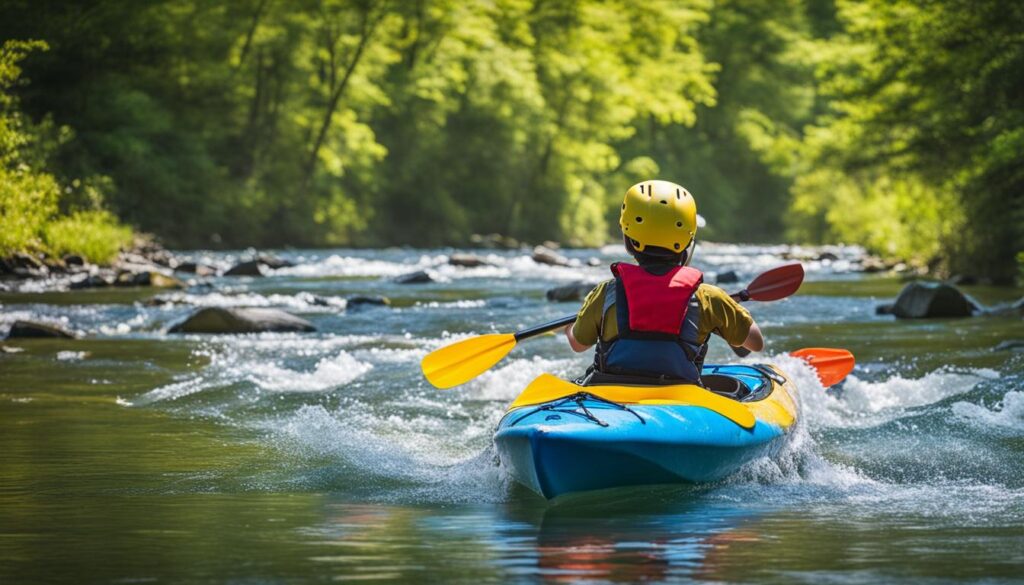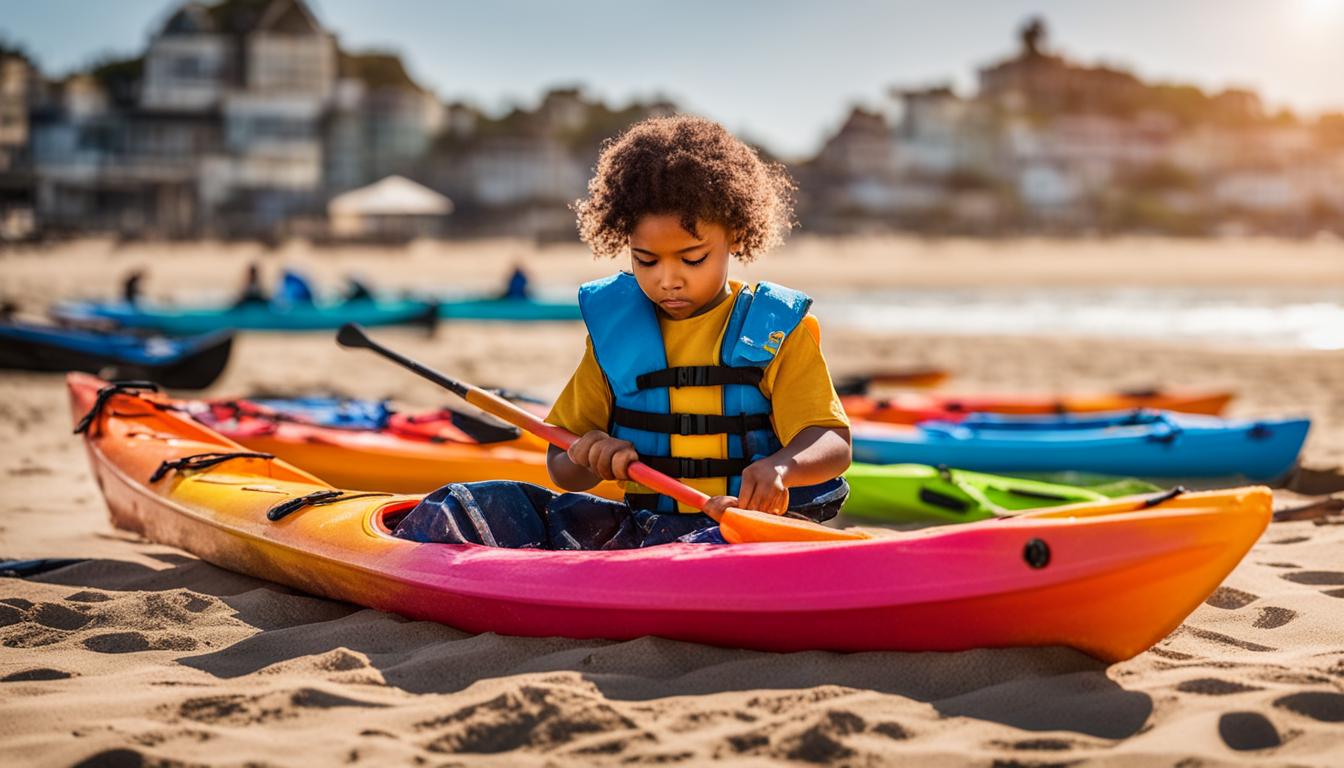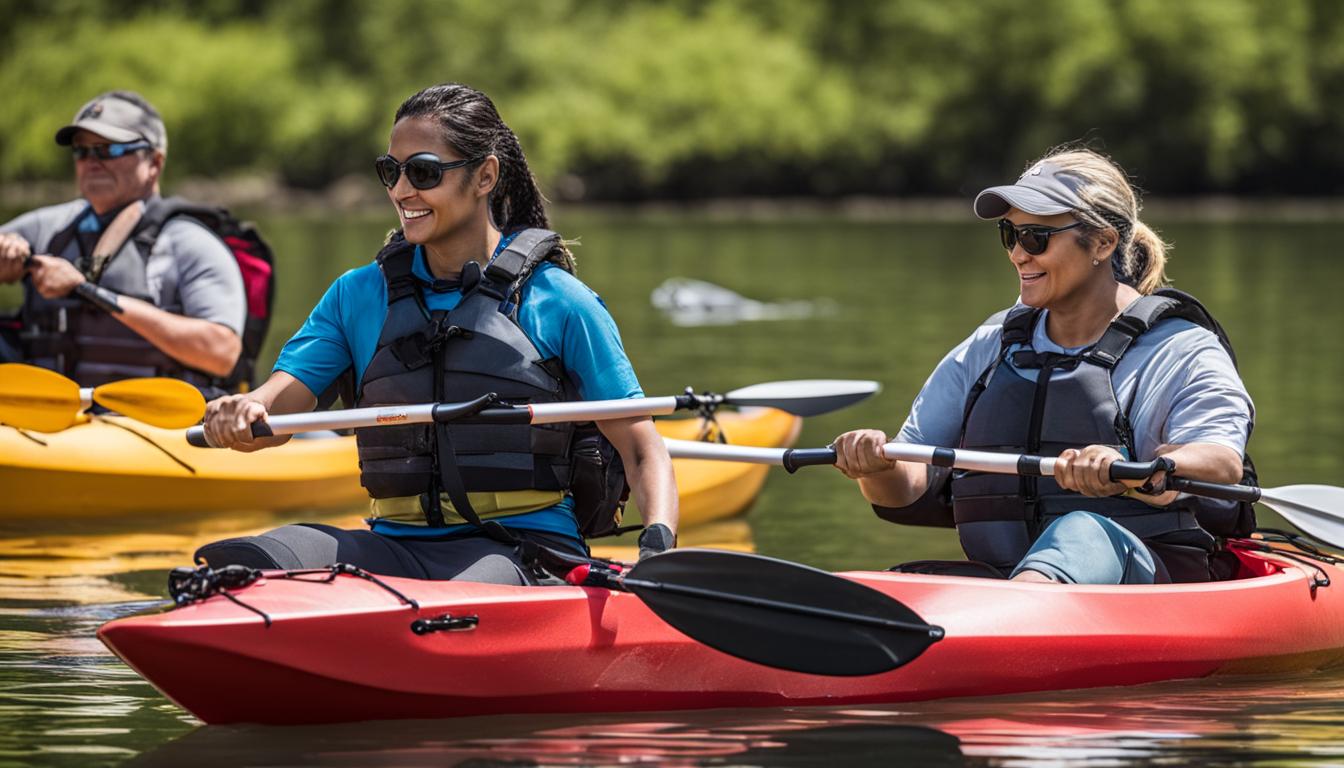Kayaking is a fantastic activity for children, offering both excitement and a connection with nature. As a parent or guardian, it’s crucial to prioritize their safety while ensuring they have a blast. By implementing appropriate precautions, you can strike the perfect balance between enjoyment and protection during their kayaking adventures. This section will provide you with valuable tips and guidelines on how to achieve this delicate equilibrium.
Key Takeaways:
- Ensuring your child’s safety while kayaking is of utmost importance.
- Implementing safety measures, such as using proper equipment and selecting suitable water conditions, is crucial.
- Provide skill development and training opportunities to enhance your child’s confidence and enjoyment.
- Choose the right equipment, including well-fitting PFDs and appropriate kayaks and paddles.
- Thorough planning and preparation can minimize risks and create a safe and enjoyable kayaking experience for kids.
Safety Measures for Kids Kayaking
Ensuring the safety of children while kayaking is of utmost importance. By implementing proper safety measures, you can create a safe and enjoyable kayaking experience for kids. Here are some essential tips to keep in mind:
1. Proper Equipment
Equip your child with the necessary safety gear, including a well-fitted PFD (personal flotation device). Ensure that the PFD is approved for their weight and size. Additionally, consider providing them with a helmet to protect their head during any potential accidents.
2. Water Conditions
Choose appropriate water conditions for your child’s kayaking adventure. Avoid strong currents, rapids, or open waters with high winds. Opt for calm and gentle waters, such as lakes or slow-moving rivers, where they can paddle with ease and minimal risks.
3. Emergency Preparedness
Teach your child about basic emergency procedures, such as how to handle capsizing or getting back into the kayak. Ensure they are familiar with self-rescue techniques like wet exits and re-entry. Equip them with a whistle to alert others in case of an emergency.
4. Constant Supervision
Always keep a close eye on your child while they are kayaking. Supervise them from the shore or accompany them in another kayak. This way, you can quickly respond in case of any potential dangers or emergencies.

By following these safety measures, you can create a secure environment for kids while kayaking, allowing them to have a fun and enjoyable experience on the water.
Skill Development and Training for Kids Kayaking
Engaging children in safe kayaking is essential for their enjoyment and overall experience on the water. By providing them with the necessary skills and training, you can ensure that they have a fun and safe time kayaking. Here are some tips and techniques to help children develop their kayaking skills:
1. Kayaking Lessons
Enrolling children in kayaking lessons is a great way to introduce them to the sport and teach them the fundamentals. Look for certified instructors who specialize in teaching kids, as they will have the knowledge and expertise to provide a safe and engaging learning environment. These lessons can cover basic paddling techniques, water safety, and rescue skills.
2. Basic Techniques
Children should be familiar with important basic techniques such as wet exits and balancing in the boat. Wet exits involve safely exiting the kayak in the event of a capsize. This skill is crucial for their safety, as it allows them to quickly and efficiently get out of the kayak if needed. Balancing in the boat helps improve stability and control, allowing children to maneuver their kayak with ease.
3. Practice Opportunities
Regular practice is key to developing skills and building confidence in kayaking. Provide opportunities for children to practice their paddling techniques in a safe and controlled environment, such as calm lakes or slow-moving rivers. Encourage them to experiment with different strokes, turns, and maneuvers while focusing on proper form and technique.
Remember, the goal is to make kayaking enjoyable and safe for children. By engaging them in skill development and training, you can help them develop their abilities and foster a lifelong love for the water.
| Skills | Importance | Training Methods |
|---|---|---|
| Basic Paddling Techniques | Essential for efficient propulsion and maneuvering | Kayaking lessons, guided practice |
| Water Safety | Crucial for children’s well-being on the water | Kayaking lessons, water safety education |
| Rescue Skills | Enables children to assist themselves and others in emergency situations | Kayaking lessons, simulated rescue scenarios |
| Wet Exits | Allows for safe and quick exit from a capsized kayak | Practice in controlled environment, supervised instruction |
| Balance and Stability | Improves control and prevents capsizing | Exercises on flatwater, training aids |
Choosing the Right Equipment for Kids Kayaking
When it comes to kids kayaking, selecting the right equipment is essential for their safety and enjoyment. By ensuring that children have properly fitting gear and suitable kayaks, you can minimize risks and enhance their overall kayaking experience.
One of the most important pieces of equipment for kids kayaking is a properly fitting personal flotation device (PFD). A PFD is designed to keep your child afloat in the water and should be worn at all times while kayaking. Make sure to choose a PFD that is specifically designed for children and fits them snugly. It should have adjustable straps and a secure closure to prevent it from coming off in case of an accident or capsize.
Along with a PFD, selecting the right kayak is crucial for children’s safety on the water. Look for kayaks that are specifically designed for kids, with a stable and easy-to-manage hull. These kayaks are typically shorter and wider, providing better stability for young paddlers. Additionally, choose a kayak that is lightweight and easy for kids to maneuver.
| Equipment | Considerations |
|---|---|
| Personal Flotation Device (PFD) | Proper fit, adjustable straps, secure closure |
| Kayak | Designed for kids, stable hull, lightweight |
| Paddle | Appropriate length, lightweight, comfortable grip |
| Gear | Throw bags, paddle floats, dry bags for personal belongings |
In addition to a PFD and kayak, choosing the right paddle is also important. Look for paddles that are the appropriate length for your child’s height, allowing them to paddle comfortably without straining their shoulders or arms. Lightweight paddles with a comfortable grip are ideal for kids to handle.
Lastly, consider the additional gear that can enhance safety and fun during kids kayaking. Throw bags are essential for rescue situations, while paddle floats can assist children in re-entering their kayaks after a capsize. It’s also helpful to have dry bags to store personal belongings and keep them protected from water.
By carefully selecting the right equipment for kids kayaking, you can ensure their safety while maximizing their enjoyment on the water. Remember to always supervise children during their kayaking adventures and teach them the importance of proper equipment usage and water safety.
Planning and Preparation for Kids Kayaking
Before embarking on a kayaking trip with your children, it is crucial to thoroughly plan and prepare to ensure their safety and enjoyment. By taking the time to assess your child’s skill level, selecting appropriate water conditions, planning for emergencies, and communicating expectations and safety rules, you can minimize risks and create a safe and enjoyable kayaking experience.
Assessing Your Child’s Skill Level
It is important to assess your child’s skill level before taking them kayaking. Consider factors such as their swimming ability, comfort in the water, and previous kayaking experience. If your child is new to kayaking, start with calm and shallow waters to build their confidence and skills. Always supervise your child closely and adjust the difficulty of the kayaking experience to match their abilities.
Choosing Appropriate Water Conditions
When planning a kayaking trip with kids, it is essential to choose appropriate water conditions. Opt for calm and gentle waters without strong currents or high waves. Avoid kayaking in extreme weather conditions or during times of low visibility. Research the water conditions beforehand and choose a location that is suitable for children’s kayaking.
Planning for Emergencies
While kayaking with kids, it is important to be prepared for emergencies. Pack essential safety equipment such as a first aid kit, a whistle for signaling, and a throw bag for rescue. Familiarize yourself with the location’s emergency services and contact information. Educate your child on basic safety procedures and what to do in case of an emergency. By being prepared, you can handle unexpected situations with confidence and ensure the safety of your children.
Communicating Expectations and Safety Rules
Prior to heading out on a kayaking adventure, communicate your expectations and safety rules to your children. Discuss the importance of wearing a properly fitting PFD (personal flotation device) at all times and explain the dangers of standing up or leaning overboard. Teach them basic paddling techniques and the importance of staying close to the group. By establishing clear rules and expectations, you can enhance their safety and enjoyment while kayaking.
By thoroughly planning and preparing for your kids’ kayaking trip, you can create a safe and enjoyable experience for everyone involved. Remember to assess your child’s skill level, choose appropriate water conditions, plan for emergencies, and communicate expectations and safety rules. By doing so, you can ensure a memorable and fun-filled kayaking adventure while prioritizing your children’s safety.

Conclusion
Creating safe and enjoyable kayaking experiences for kids is possible by following the right strategies and guidelines. By prioritizing your child’s safety, you can ensure that they have a fantastic time on the water.
Teaching kids safe kayaking habits is essential in fostering their love for this thrilling activity. By providing them with proper training and practice opportunities, they can develop their skills and confidence, allowing them to navigate the water with ease.
Additionally, selecting the right equipment is crucial for their safety and enjoyment. Make sure to choose well-fitting personal flotation devices (PFDs), suitable kayaks, and paddles that are appropriate for their size and skill level. Equipping them with essential gear like throw bags and paddle floats will further enhance their safety.
Lastly, thorough planning and preparation are vital before embarking on a kayaking trip with kids. Assessing their skill level, selecting appropriate water conditions, and communicating expectations and safety rules are all key considerations. By being well-prepared, you can minimize risks and create a safe and enjoyable experience for your children.
FAQ
How can I ensure my child’s safety while kayaking?
It is important to prioritize safety when kayaking with kids. Ensure they wear proper equipment like PFDs (personal flotation devices), choose appropriate water conditions, and have a plan for emergencies. Teach them safe kayaking habits and provide a safe environment.
What skills do children need for kayaking?
Children should develop essential kayaking skills. This includes taking lessons, practicing techniques like wet exits and balancing in the boat, and building confidence on the water. Engaging in safe and enjoyable kayaking practices helps develop these skills.
How do I choose the right equipment for kids kayaking?
Selecting appropriate equipment is crucial. Ensure they have properly fitting PFDs, suitable kayaks and paddles, and essential gear like throw bags and paddle floats. The right equipment enhances their safety and enjoyment while kayaking.
What should I consider when planning a kayaking trip with kids?
Adequate planning and preparation are essential. Assess the child’s skill level, choose appropriate water conditions, plan for emergencies, and communicate expectations and safety rules. By planning carefully, you can create a safe and enjoyable kayaking experience for kids.
How can I balance fun and safety in children’s kayaking?
By prioritizing safety measures, providing skill development and training, choosing the right equipment, and thorough planning and preparation, you can create a safe and enjoyable kayaking experience for kids. Always prioritize their safety while fostering their love for kayaking.





